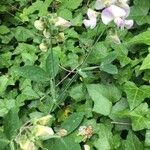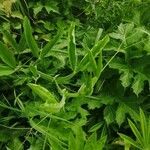Annual herbs, 50-200 cm tall. Stem climbing, much branched, somewhat hairy, winged. Leaves with branched tendril at apex; rachis winged; stipules semisagittate; leaflets 1-paired, ovate-oblong or elliptic, 20-60 × 7-30 mm, with pinnate veins, rarely subparallel veins, margin entire. Raceme longer than leaf, 1-3(or 4)-flowered. Calyx campanulate, equally toothed and longer than tube. Corolla usually purple, or other colors, 20-30 mm. Ovary linear; style twisted. Legume brown-yellow, linear, 5-7 cm, pubescent. Seeds smooth. Fl. and fr. Jun-Sep.
An annual herb. The stem is hairy and winged. The leaves are compound with two leaflets. These are 2-6 cm long by 7-30 mm wide. There are 1-3 flowers in a group. They can be white, pink, purple or blue.
A wing-stemmed annual with fragrant fls 2–4 cm, occasionally escapes, but apparently does not persist.












